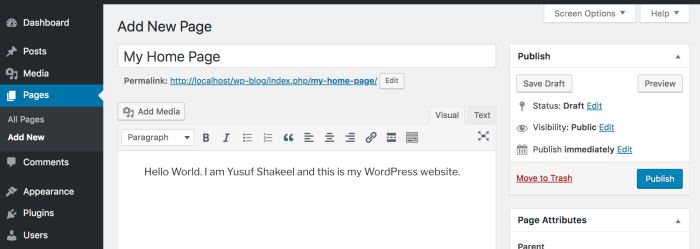Creating a custom homepage in WordPress allows you to break free from the default template and craft a truly unique online presence. This guide provides a detailed, step-by-step process for building a custom homepage, covering various methods and considerations for different skill levels. Whether you’re a beginner or an experienced user, you’ll find valuable insights and actionable advice here.
We’ll cover everything from choosing the right theme and page builder to customizing elements and optimizing for .

Source: nebulasdesign.com
Understanding WordPress Homepage Options
Before diving into customization, let’s understand the different approaches to creating a WordPress homepage:
- Using a Page as your Homepage: This is the most common and recommended method. You create a standard page and set it as your static homepage in WordPress settings. This offers maximum flexibility and control.
- Using a Custom Template: For advanced users, creating a custom template file allows for unparalleled design freedom. This requires coding skills and a deeper understanding of WordPress’s template hierarchy.
- Utilizing Page Builders: Page builders like Elementor, Beaver Builder, and Divi offer drag-and-drop interfaces to easily create and customize your homepage without coding. They provide pre-built templates and widgets for a faster workflow.
Method 1: Creating a Custom Homepage with a Page and Page Builder (Recommended for Beginners and Intermediate Users)
Step 1: Choosing a WordPress Theme
Your theme provides the foundational structure and style of your website. Select a theme that’s flexible and compatible with your chosen page builder. Look for themes with strong customization options and good reviews. Consider factors like responsiveness (adapting to different screen sizes), speed, and optimization.
Step 2: Installing and Activating a Page Builder
Popular page builders like Elementor, Beaver Builder, and Divi offer intuitive interfaces for creating custom layouts. Install and activate your chosen page builder through your WordPress dashboard (Plugins > Add New).
Note: Many themes come bundled with page builders or have excellent compatibility with specific ones. Check your theme’s documentation for recommendations.
Step 3: Creating a New Page
Navigate to Pages > Add New in your WordPress dashboard. Give your page a title (e.g., “Homepage”).
Step 4: Designing Your Homepage with the Page Builder
This is where the page builder comes into play. Use its drag-and-drop interface to add sections, columns, widgets, and content elements. Experiment with different layouts and styles to achieve your desired design. Consider including:
- Hero Section: A visually striking section at the top, often featuring a headline, subheading, and call to action (CTA).
- About Us Section: Briefly introduce your business or brand.
- Services/Products Section: Showcase your offerings.
- Testimonials Section: Build trust and credibility.
- Contact Section: Make it easy for visitors to reach you.
- Blog Section: Feature your latest posts.
Step 5: Setting the Custom Page as Your Homepage
Once your homepage is designed, go to Settings > Reading. Under “Homepage displays,” select “A static page” and choose your newly created page from the dropdown menus for “Homepage” and “Posts page” (if you want a separate blog page).
Method 2: Creating a Custom Homepage with a Custom Template (Advanced Users)
This method requires coding skills in PHP and a solid understanding of WordPress’s template hierarchy. You’ll need to create a custom template file (e.g., `page-homepage.php`) and place it in your theme’s directory. This file will contain the HTML, CSS, and PHP code for your custom homepage design. This approach offers the greatest flexibility but is significantly more complex.
Resources: The WordPress Codex provides detailed information on template files and the template hierarchy: https://developer.wordpress.org/themes/basics/template-files/
Optimizing Your Custom Homepage for
Once your homepage is designed, optimize it for search engines to improve your website’s visibility:
- Use relevant s: Incorporate s naturally within your content, headings, and meta descriptions.
- Optimize images: Use descriptive alt text for images and compress them for faster loading times.
- Improve page speed: Use a caching plugin and optimize your images to improve your website’s loading speed.
- Use internal and external links: Link to relevant pages within your website and authoritative external sources.
- Create a sitemap: Submit your sitemap to Google Search Console to help search engines crawl your website more efficiently.
Frequently Asked Questions (FAQ)
- Q: Can I use multiple page builders on one page? A: While technically possible, it’s generally not recommended. It can lead to conflicts and performance issues. Stick to one page builder for consistency.
- Q: How do I add a contact form to my homepage? A: Many page builders offer contact form widgets, or you can use plugins like Contact Form 7 to create and integrate a form.
- Q: What if my custom homepage doesn’t look right? A: Check your theme’s documentation, inspect your code for errors (if you used a custom template), and seek help from WordPress support forums or communities.
- Q: How do I update my homepage later? A: Simply edit the page in your WordPress dashboard and use the page builder to make changes. Save your changes, and they will be reflected on your live website.
- Q: Is it better to use a page or a post for my homepage? A: Always use a page. Pages are designed for static content, while posts are for blog entries.
Call to Action (CTA)
Start creating your dream WordPress homepage today! Choose the method that best suits your skill level and begin building a website that truly reflects your brand and captivates your audience. Remember to regularly update your content and optimize for to maximize your online success.
Questions Often Asked
Can I use a page builder to create a custom homepage?
Yes, many popular page builders like Elementor, Beaver Builder, and Divi seamlessly integrate with WordPress, offering drag-and-drop interfaces for easy homepage creation.
What are the advantages of a custom homepage over a default one?
A custom homepage allows for complete control over design and functionality, enabling better brand representation, improved user experience, and enhanced optimization compared to a generic template.

Source: googleapis.com
Do I need coding skills to create a custom homepage?
While basic HTML and CSS knowledge can be helpful, many methods, including page builders, allow for custom homepage creation without extensive coding expertise.

Source: googleapis.com
How often should I update my homepage?
The frequency depends on your business needs. Regularly updating your homepage with fresh content, offers, and promotions can keep it engaging and relevant to your audience.